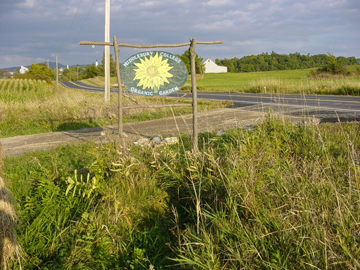
Farmelton
The Carleton Farm
A project of the Bio 160 Agroecology Course

College Name: Middlebury College
Brief Description of College
A highly selective, private liberal arts college of about 2,350 undergrads in Middlebury, VT. The college consists of a 350-acre main campus in the Champlain Valley and an 1800-acre mountain campus, and is renowned for its strong language, international studies, and environmental studies programs.
Farm Size
The Middlebury College Organic Garden (MCOG) consists of about ¾-1 acre of land producing crops for sale, with an additional ½ acre devoted to a cover crop. It is located in a small knoll of stony, sandy loam soil (in contrast to the clay soil most characteristic of the area), which is more forgiving, and allows planting to take place in earlier in the spring, thereby increasing the opportunity for student involvement.
Produce of Farm and Where it Goes
The garden produces mixed vegetables—lettuces, spinach, Swiss chard, sugar snap peas and such on a larger scale for dining services, and smaller amounts of tomatoes, golden beets, and just about everything else for smaller venues, such as the smallest of Middlebury’s three dining halls, the environmental house (through a CSA), and local restaurants. Herbs and flowers are also grown between rows to attract pollinators, and the gardens bee hives can produce up to 70lbs. of honey in a good year.
Farming Approach
The MCOG is organic in terms of methodology and spirit, and sees no advantage in applying for certification. Their approach is geared towards sustainability, emphasizing optimum over maximum production. The garden relies heavily on compost bought from the college, but also uses cover crops as green manure and nitrogen-fixing crops to increase its soil organic matter. Additional inputs, such as lime and liquid fish fertilizer, are purchased from larger manufacturers, as are some OMNI-approved herbicides and pesticides. The use of these manufactured products is minimized as much as possible. Although a rototiller is sometimes used to even out new beds and till in hay grasses, most of the work in established beds—for example, the mulching in of cover-crops—is done by hand. At the moment, the MCOG mostly follows the French intensive system of “double dug” raised beds, but always remains open to experimenting with various sustainable practices. In order to accommodate the slope of the land, the garden is built planted in contours, which, when combined with the incredible variety of its rotation schemes, provides for a highly manageable and beautiful plot of different colors, textures, and shapes. Clover paths in between beds fix nitrogen in the soil, while also decreasing runoff and erosion. There is a small college greenhouse that is used to start some tomato and onion seedlings, but most warm-whether crops are grown a hoophouse, which minimizes the risk of bacterial and fugal disease.
How Farm is Funded
Grants, fundraising projects, and especially alumni contributions fund inputs and improvements for the MCOG. As a subsidized farm, the MCOG exists not to make a profit from its produce, but rather to serve as an educational tool, and therefore is not self-sustained financially.
How Farm is Staffed and Supervised
The MCOG is supervised by a manager (Jay Leshinsky, who has been a member of the local farming community for 35 years), and maintains part-time and full-time summer interns through alumni gifts. As a student-run garden, the MCOG is unable to offer the work-study positions and academic credits that an institutionally-supported organization could, and depends greatly upon student and community volunteers during the spring and fall. Local farmers have been especially useful in lending their equipment, as well as expertise to help solve problems the MCOG has faced through the past five years. There are also students in leadership positions who act as liaisons to connect people, manage PR, mediate between contending factions, hear the needs of the community, develop ideas, and generally advocate for the welfare of the garden and its place in the Middlebury community.
Purposes of Farm
The degree to which the MCOG is integrated into Middlebury varies. About eight or nine professors take advantage of the garden regularly, bringing not only geology, geography, botany, biology, and environmental studies classes, but also English, history, dance, and teacher’s education students to enjoy the atmosphere of the setting. While the general student body lacks some of the enthusiasm with which this project began, many are still involved in the MCOG’s harvest festival every fall, and contribute to larger, short-term involvement projects, such as last year’s planting of trees to serve as wind breaks. Once established, it has become more difficult to encourage many students to invest themselves in the MCOG, as the incentives seem few: it is entirely extracurricular, the payback is much more subtle, as creative energy goes more towards maintenance and refining, rather than any radical changes, and it requires a lot more time than can easily be accommodated to the school year of the busy Middlebury student. During the summer is when students can enjoy the garden properly. Visits to local farms for observation, tours, joint projects and partnerships are common, and students can foster a greater sense of their rightful ownership over the MCOG by witnessing its daily and seasonal cycles. During the school year, though, students have been able to interact with and contribute to the garden through independent studies, especially in the early stages of the MCOG’s development. Such studies have resulted in the original garden design, a solar powered well pump, and the children’s garden program, to name a few.
How Farm was Initiated
The MCOG was established by two students, Jean and Bennett, who believed in creating a place where students could escape the digital-driven world and experience a more biological sense of time. They came up with a plan of what they hoped to accomplish with in five years, found a good piece of land, and started looking for support around the campus. On the administrative side, they were generally met with much resistance and negativity, and it was finally the college president who reached into his discretionary budget to finance the project. With a year of internal grants from the college, and approval to use the land, the students grew their first cover crop, and began planting in the spring of 2003.